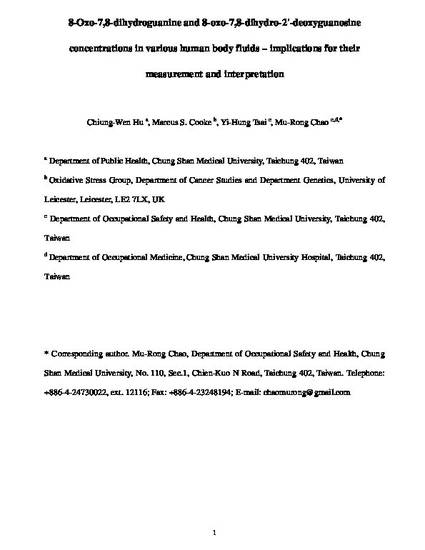
8-Oxo-7,8-dihydro-2'-deoxyguanosine (8-oxodGuo) is the most investigated product of oxidatively damaged DNA lesion that has been associated with the development of aging, cancer and some degenerative diseases. Here, we present the first liquid chromatography-tandem mass spectrometry method that enables the simultaneous measurement of its repair products in plasma and saliva, namely 8-oxo-7,8-dihydroguanine (8-oxoGua) and 8-oxodGuo. Using this method, we investigated the underlying transport mechanism of the repair products of oxidatively damaged DNA between cellular compartments and biological matrices. Plasma, saliva and urine samples were collected concurrently from 57 healthy subjects. Various deproteinization methods were evaluated, and the precipitants acetonitrile and sodium hydroxide-methanol were, respectively, selected for plasma and saliva samples due to their effect on recovery efficiencies and chromatography. The mean baseline concentrations of 8-oxoGua and 8-oxodGuo in plasma were demonstrated to be 0.21 and 0.016 ng/mL, respectively, while in saliva they were 0.85 and 0.010 ng/mL, respectively. A relatively high concentration of 8-oxoGua was found in saliva with a concentration factor (CF, concentration ratio of saliva to plasma) of 4 as compared to that of 8-oxodGuo (CF: 0.6), implying that 8-oxoGua in plasma may be actively transported to saliva, whereas 8-oxodGuo was most dependent on a passive diffusion. Good correlations between urine and plasma concentrations were observed for 8-oxoGua and 8-oxodGuo, suggesting that blood was a suitable matrix in addition to urine. Significant correlation between 8-oxoGua and 8-oxodGuo in urine was only observed when the concentrations were not corrected for urinary creatinine, raising the issue of applicability of urinary creatinine to adjust 8-oxoGua concentrations.

Post Print Version.
The version of record of this article (doi:10.1007/s00204-014-1255-1) contains supplementary material, which is available to authorized users.
Originally published in the Archives of Toxicology.